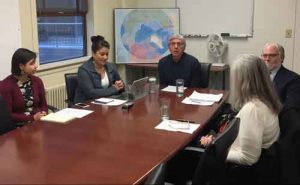
JUNEAU — Alaska and British Columbia (BC) officials began the implementation of the groundbreaking Statement of Cooperation (SoC) to address transboundary mining and water quality concerns in Southeast Alaska with their first Bilateral Working Group (BWG) teleconference meeting last week.
Lieutenant Governor Byron Mallott opened the Friday, December 16, 2016, meeting, along with BC Minister of Energy and Mines Bill Bennett. The BWG is comprised of the commissioners of the Alaska Departments of Environmental Conservation (ADEC), Fish and Game (ADF&G), Natural Resources (DNR), and the deputy ministers of the British Columbia Ministries of Environment and Energy and Mines.
The SoC was signed by Alaska and BC in October and provides for coordinating on a water quality monitoring program, exchanging information on the environmental performance of BC mines, enhancing existing opportunities for Alaskans to receive information and comment on new mining projects in BC, and otherwise enhancing the communication and collaboration between Alaska and British Columbia on water quality concerns.
“We have come a long way with the help of many citizens in Alaska and British Columbia who care deeply about the quality of our water, our fisheries, and way of life, and I thank them,” said Lt. Gov. Mallott. “However, we know success will only be measured by how well we do going forward. I was pleased with the commitment I saw in Friday’s meeting to protecting Southeast waters.”[xyz-ihs snippet=”Adsense-responsive”]ADEC is the lead for the state in implementing a water quality monitoring program that will facilitate the sharing of water quality and related data collected in transboundary watersheds and marine waters. “The intent is to have reliable data on current and future conditions so we can spot any changes of concern and act on them before we see significant impacts,” said ADEC Commissioner Larry Hartig. “Although we appreciate all of the additional safeguards and government oversight BC and the Canadian federal government have been putting in place relating to mining concerns, we are expecting more commercial development and shipping in the area and believe having a monitoring program like this in place is wise.”
Over the next four years, ADEC will be using EPA grant funds it receives to help support work in Alaska on this program. ADEC will be seeking additional federal assistance and forming collaborations with others performing monitoring in the area. “We are particularly pleased with the monitoring work being done by Central Council Tlingit and Haida Indian Tribes of Alaska,” Hartig said. “We look forward to collaborating with them in a number of ways, including incorporating into our data set the valuable data they are collecting and getting their help in collecting traditional ecological knowledge, a key piece of this joint monitoring project.”
A team of six technical staff from the Alaska and BC agencies responsible for developing the joint monitoring program will be working with Tribes, First Nations, federal agencies, and stakeholders over the next four months to prepare a draft program description and work plan for consideration by the BWG.
DNR is the state’s lead for developing and implementing the procedures Alaska and BC will use to exchange information and concerns relating to existing and future mine projects, including on environmental performance. While Alaska and BC agencies have already been exchanging information and technical comments, under the SoC the agencies will post this shared information, analyses, and comments on public websites, and there will be more opportunities for the public to engage with the regulators on topics of concern. According to Deputy Commissioner of DNR Ed Fogels, his department has been working with BC on a draft set of protocols and procedures it expects to propose to the BWG in January to help implement these provisions of the SoC. “DNR has already seen a ramping up of the information we have been getting from BC,” noted Fogels. ”In addition, DNR is developing an interactive web-based map that will make it easier for the public to get information about mining projects in BC. We plan to have this ready for demonstration as early as next month.”
ADF&G is the state’s lead for developing a communication plan describing how Alaska and BC will make available to the public the data, information, and analyses shared under the SoC. Greater transparency is a key element of the SoC. “Our central goals are providing user-friendly access to reliable information and more meaningful engagement with Tribes, First Nations, and stakeholders,” according to David Rogers, Director of Habitat at ADF&G. “We expect to have a detailed outline of the draft plan to present to the BWG and public in January.”
The SoC calls for the draft plans for the water quality monitoring program and the Communication Plan to be taken up by the BWG no later than April 2017. There will be opportunities for Tribes, First Nations, and the public to review and have dialog with the BWG and its member agencies on the drafts before then. Among other things, ADEC will host a public workshop to provide an opportunity for the public to provide its input to the technical staff from ADEC, ADF&G, and DNR working on plans for the joint water quality monitoring program.
Source: State of Alaska
[xyz-ihs snippet=”Adsense-responsive”]
